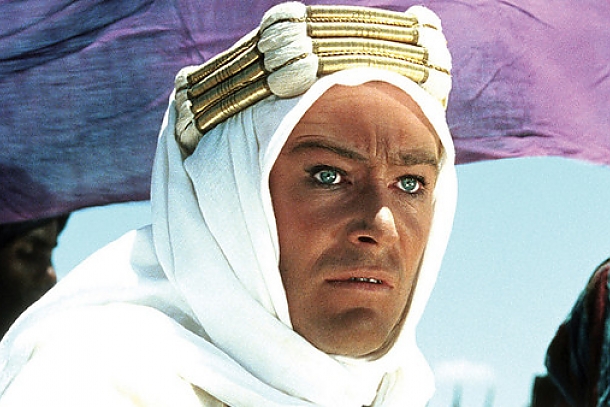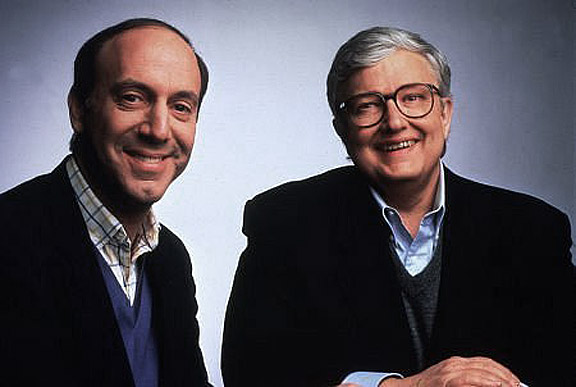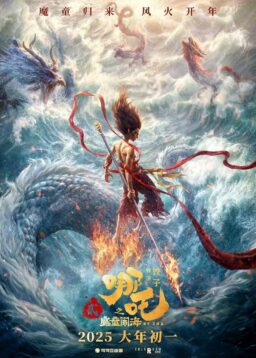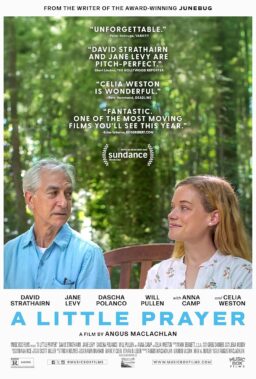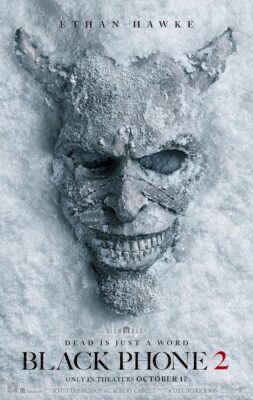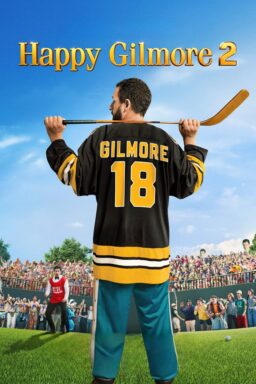When Chicago’s legendary Music Box Theatre became one of the 100 or so movie theaters chosen to exhibit Quentin Tarantino’s “The Hateful Eight” as a so-called “roadshow” presentation with all the bells and whistles, including the projection of actual celluloid prints in the largely defunct 70mm format, it had a leg up on most of its competitors. The Music Box already had the special projectors needed to screen it—one of the advantages of being an old-style movie palace dating back to 1929. However, to give audiences the best possible presentation of the film, the theater did upgrade its sound system and undertook the temporary installation of a new 41-foot-tall screen that would better display the advantages of the format. The effort certainly paid off—“The Hateful Eight” was a huge hit for the theater—but it must have seemed to be a bit of a waste to go through all of that effort just for one movie.
Therefore, to give that replacement screen a proper send-off before it is taken down, the theater will be presenting “70mm Film Festival: The Ultimate Edition,” the third iteration of a program of 70mm films that began back in 2013 as a way of exhibiting some of Hollywood’s most spectacular visions in the manner in which they were meant to be seen. Running February 19 thru March 10, along with a separate shorts program of short films and trailers, the Music Box will be showing 14 features—some of them in prints from their original theatrical runs—that run the gamut from Oscar-winning classics to cult oddities to contemporary uses of the format. In an era when moviegoers are increasingly content to view films in multiplexes or on their computers or smartphones, this is a rare chance to see a collection of epic visions in the most sensorially overwhelming manner possible—the kind of cinematic experience that can make someone fall in love with the cinema all over again. (Films that are playing in the festival will be highlighted in bold.)
For those wondering what the big deal is, 70mm is a film gauge that is twice as wide as conventional 35mm film (actually, the picture information takes up 65mm of the frame with the remaining 5mm going to four magnetic strips containing six tracks of sound). This means that as the wider film unspools, more light goes through the projector gate and as a result, what appears on the screen has nearly four times the clarity of normal 35mm film—the colors are deeper, richer and the image as a whole displays a stunning sharpness. From the earliest days of the cinema, there were experiments with this kind of widescreen presentation. In the late 1920s, Fox experimented with a process that they dubbed Fox Grandeur. Although a few films were made in the format—most notably 1930’s “The Big Trail” (a Raoul Walsh Western that featured John Wayne in one of his most significant early roles)—but it was soon abandoned when theater owners, who were then in the process of reconfiguring for sound, showed little interest in dealing with a new projection format as well.
In the 1950s, with television threatening to overtake the entire film industry, Hollywood was trying to lure audiences back into theaters with things that they could not get on the tube. One amusement was widescreen photography that could give films an epic feel far removed from the small, square TV tubes of the time. In the wake of Cinerama, a process that required a giant curved screen and three 35mm projectors working in perfect synchronization, impresario Michael Todd was determined to create a similar process that would utilize only one projector. He came up with what came to be known as Todd-AO. After the successful releases of such Todd-AO titles as “South Pacific” (1955) and “Around the World in 80 Days” (1956), other companies began developing their own super-widescreen processes. One of the most famous of these formats was VistaVision, a version developed by Paramount Pictures that positioned the film in the camera horizontally in order to achieve a finer-grade image.

Advancements in the development of film stocks rendered the format obsolete after only seven years (a version of it would be revived in the late 1970s and employed for shooting visual effects sequences in such films as the original “Star Wars” trilogy, ”Tron” (1982) and “Who Framed Roger Rabbit” [1988]) but during that period, it was employed on such classics as “White Christmas” (1954), “The Ten Commandments” (1956) and “One-Eyed Jacks” (1961). One director who made especially good use of it was Alfred Hitchcock, who utilized the process on “To Catch a Thief” (1955), “The Trouble with Harry” (1955), “The Man Who Knew Too Much” (1956), “Vertigo” (1958) and “North by Northwest” (1959). Of those films, “Vertigo” remains his most impressive use of the format for how it allowed him to use color as a way of further evoking the emotional and psychological journey that he put both his characters and his audience through. Throughout the film, he uses specific colors to underscore certain moods—from the blue for James Stewart’s guilt over the death in the opening scene that he feels responsible for, to the green that comes to represent Kim Novak, the focus of the eventual obsession that threatens to destroy him, to the bright reds that turn up from time to time to serve as unheeded warnings. The deep and rich depictions of these colors made possible by VistaVision are both gorgeous and terrifying to behold.
Over the next few years, studios would utilize 70mm for their most epic-scaled productions and would show them in that format in the best theaters in the biggest cities as roadshow presentations before going out into wider release in conventional 35mm prints. “West Side Story” (1961) used it to help bring the Broadway smash to the big screen and while the end result may be a bit shaky in parts to contemporary viewers, Daniel Fapp’s Oscar-winning cinematography (one of 10 the film received, including Best Picture) captured Jerome Robbins’ legendary choreography with such detail that one can forgive the film for its occasional hiccups. An even better use came a year letter with David Lean’s 1962 epic “Lawrence of Arabia,” in which the format proved to be the ideal manner of presenting the beauty, mystery and danger of the desert. This is regularly cited as one of the greatest movies ever made and much of that is due to the visceral reaction that Freddie Young’s cinematography inspires in viewers. The scene in which we look upon a vast desert landscape and gradually pick out a speck in the distance that slowly reveals itself to be a person is one of those images that sends chills down the spine no matter how many times you see it.
The next year saw 70mm utilized to capture two of the biggest productions in Hollywood history. The first was “Cleopatra,” the notorious, budget-busting epic historical drama that kicked off the legendary love affair between co-stars Elizabeth Taylor and Richard Burton and nearly bankrupted 20th Century Fox in the process. Seen today, a half-century removed from its controversial production and release, it is not exactly a great movie by any means—even though it clocks in at a staggering 248 minutes, it still feels as if large chunks of narrative were chopped out seemingly at random (which was evidently the case). But, the film by no means deserves the disaster tag still applied to it. If nothing else, the money spent is definitely all up there on the screen and some of the elaborate set pieces, as captured by Leon Shamroy’s Oscar-winning cinematography, can still cause jaws to drop today in ways that the current glut of CGI spectaculars can not even begin to approach.
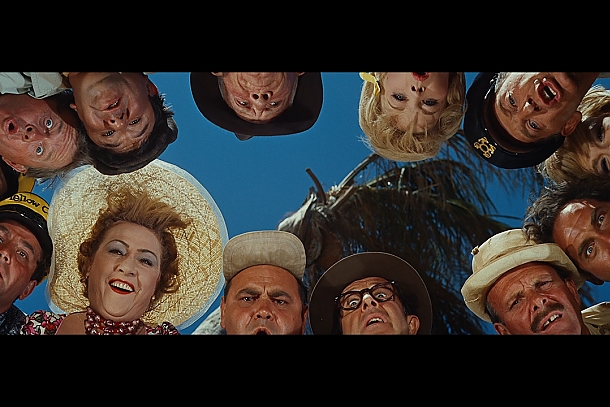
This is not to say that all films utilizing the format were serious-minded epics with nary a laugh to be had. Later in 1963 saw the release of Stanley Kramer’s “It’s a Mad, Mad, Mad, Mad World,” in which the director, who usually gravitated towards heavy dramas along the lines of “On the Beach,” presented viewers with a wild, knockabout farce. Most of the top comedic talents of the day turned up—some in leads and some in cameos—to take part in the story of a bunch of ordinary people who find themselves in the middle of an increasingly destructive race to find a fortune in money that has been hidden under a big “W.” Shot in a process meant to replicate the expanse of Cinerama while utilizing only one camera, even it barely managed to contain all the on-screen chaos (it feels at times like a series of overstuffed MAD Magazine panels come to life). While the sheer amount of slapstick and noise may prove to be too much for some viewers, it really is one of the damnedest things that you will ever see. Two years later, British director Ken “The Pirate Movie” Annakin tried his hand at epic comedy with “Those Magnificent Men in Their Flying Machines” (1965), which chronicled the wackiness surrounding a London-to-Paris air race set during the early days of aviation. The end result was wildly uneven, but the special effects employed to bring the airborne sequences to life are still neat to watch.
Soaring even higher than “Those Magnificent Men in Their Flying Machines,” both figuratively and literally, was Stanley Kubrick’s 1968 masterpiece “2001: A Space Odyssey.” Originally intended to be shot in full Cinerama, it was eventually filmed in the more conventional Super Panavison 70 process when special effects supervisor Douglas Trumbull pointed out that it offered less chance for visual distortion. To sum up the number of achievements that Kubrick pulled off with this film—a work that still dazzles and divides audiences today—in a mere paragraph is impossible so I will not even try. However, I will note that over the years, I have seen the film in almost every possible circumstance and can promise that the chance to see the film in 70mm is the kind of opportunity no film fan should pass up. To miss it is to miss one of the great moviegoing experiences of all time. In fact, I would go so far as to say that if you have not seen “2001” projected on a big screen in this manner before, then you have not really seen it.
By this time in film history, however, filming in 70mm was becoming increasingly rare—it was just too expensive to produce and the number of big city movie palaces equipped to properly present such films were beginning to go by the wayside as multiplexes began to dominate the exhibition game. From this point on, most 70mm presentations were actually blow-ups of 35mm prints—a more economical process that wasn’t quite as visually spectacular as pure 70mm, but which was still more impressive than conventional 35mm and had the added benefit of vastly improved sound quality. Sam Peckilnpah’s groundbreaking revisionist Western “The Wild Bunch” (1969), for example, was originally shot in 35mm and then blown up to 70mm. But to see it in the latter format is clearly the way to go, as it offers up a better canvas for the work of cinematographer Lucien Ballard, and the enhanced soundtrack brings an extra oomph to such classic moments as the bridge explosion and the climactic shootout sequence.
With the advent of six-track Dolby Stereo sound in the mid-Seventies, many of the big sci-fi, fantasy and action spectaculars would put out a few blowup prints in 70mm for theaters still equipped to play them and knowledgable film fans would seek them out. Moviegoers could marvel in the splendor of the Stay-Puft Marshmallow Man attacking New York in “Ghostbusters” (1984) or marvel in the compositions achieved by widescreen master John Carpenter in his cross-country alien romance “Starman” (1984) or revel in the cheerful goofiness of the sci-fi/fantasy hybrid “Krull” (1983).

SELF-INDULGENT AUTHOR’S NOTE: While I am excited at the prospect of seeing all of the films being presented at this festival, I must admit that the one that I am giddiest about experiencing again in all its splendor is perhaps the one least familiar to many of you reading this—the one and only “Krull.” In this crazy-as-hell combination of the science fiction and fantasy genres, two warring kingdom on the faraway planet of Krull are about to be united by the wedding of Prince Colwyn (Ken Marshall) and Princess Lyssa (Lysette Anthony). The ceremony is attacked by the forces of The Beast, an alien creature who has arrived in a giant spaceship known as the Black Fortress, who proceed to kill the two kings and decimate their armies while absconding with Lyssa and leaving Colwyn for dead. Colwyn is nursed back to health by an old sage who informs him that The Beast can only be defeated with the use of a weapon known as the Glaive—sort of an elaborate version of a throwing star—and proceeds to set off on a quest with a ragtag group of misfits (including the likes of Robbie Coltrane and Liam Neeson) on a perilous quest to retrieve the Glaive and track down the Black Fortress to defeat the Beast and rescue Lyssa before it is too late. An admittedly cynical attempt to cash in on the success of both “Star Wars” and the likes of “Conan the Barbarian” that marked director Peter Yates’ first and only stab at blockbuster filmmaking (he would also make the much smaller “The Dresser” later that same year), the film is an undeniable mess and it is perhaps not surprising that it turned out to be a massive box-office flop in the summer of 1983. That said, the mashup of genres is so cheerfully lunatic throughout and it has been produced on such a lavish scale that I am willing to forgive the fact that the story is silly, the romantic leads are barely substantial enough to be described as cardboard and that none of it makes a lick of sense. (The Glaive is also pretty awesome.) In recent years, the film has begun to develop a small cult and while the same could be said about practically every film of the Eighties other than “Chu Chu and the Philly Flash,” this is one that really deserves a second look.
One of the most unusual deployments of the 70mm format during this time came also in 1983 when director Douglas Trumbull designed his intermittently fascinating thriller “Brainstorm”—which dealt with the development of a machine that allowed people to record the brainwaves created by certain experiences and play back their sensations, including what happens when you die. It was a showcase for his proposed Showscan system, a 60-frame-per-second, 70mm process that would lend a level of hyper-clarity to the vision sequences. When that proved to be unfeasible, the film was reconfigured so that the regular scenes would play out in conventional widescreen and expand to 70mm for the eye-popping vision sequences.
In the Nineties, developments in digital sound meant that 35mm prints could have the same sound quality as 70mm at a much reduced cost and as a result, the larger format went almost entirely by the wayside. Excluding such rare events as the globe-trotting documentary “Baraka” (1992) and Kenneth Branagh’s adaptation of “Hamlet” (1996), the mantle of large-gauge film production and exhibition was passed on to IMAX, which used a variation of the old VistaVision process.

In recent years, perhaps as a response to the onset of digital filmmaking and the near-total obsolescence of celluloid, a number of filmmakers have endeavored to keep the 70mm flame alive. The great Terrence Malick used it to shoot portions of “The New World” (2005), “The Tree of Life” (2011) and his alternately beautiful and baffling new film “Knight of Cups.” Over the course of his last four films, Christopher Nolan has gone from shooting roughly 20 minutes of “The Dark Knight” (2008) in IMAX to nearly an hour’s worth with “The Dark Knight Returns” (2012), to virtually all of “Interstellar” (2014), a sci-fi epic that rivals the likes of “2001” in terms of scale and technical prowess. When writer/director Paul Thomas Anderson made his acclaimed drama “The Master” (2012), he originally intended to shoot roughly 20% of his tale of an alienated young man (Joaquin Phoenix) falling under the spell of the charismatic leader of a new religious movement (Philip Seymour Hoffman) in 70mm, but wound up shooting nearly the entire thing in the process (the first narrative film to do so since the aforementioned “Hamlet”). Even though there were few theaters still equipped to show it in its original form, it did manage to play most of those places to a strong commercial response. When Anderson went on to make his next film, his ingenious Thomas Pynchon adaptation “Inherent Vice” (2014) he shot it in 35mm but had a couple of 70mm prints blown up from it that have only received a handful of public screenings to date. And, of course, there is “The Hateful Eight,” in which Tarantino and cinematographer Robert Richardson managed to come up with a number of striking and richly detailed images despite the fact that the vast majority of it was set within the confines of a snowed-in watering hole.
Despite the efforts of filmmakers like Tarantino, Anderson, Nolan and Malick, it is highly unlikely that 70mm will ever make any sort of significant comeback—it is simply too expensive of a format to inspire widespread usage. Even if that weren’t the case, there just aren’t enough theaters able to project it left to make it viable as anything other than a special event (remember that even a release as highly publicized as “The Hateful Eight” only landed in about 100 theaters or so). To make matters worse, the prints and projectors that currently exist aren’t getting any younger and once they fall into disrepair, it is highly unlikely that new ones will be made to replace them. That is what elevates this festival to the status of a must-see event for film fanatics and casual moviegoers alike—it may suggest the last gasps of 70mm filmmaking, but it is certain to take anyone’s breath away in the process.
Although run-of-festival passes are sold out, there are still tickets available for the individual screenings. For more information on the festival, including screening dates and times, click here.

